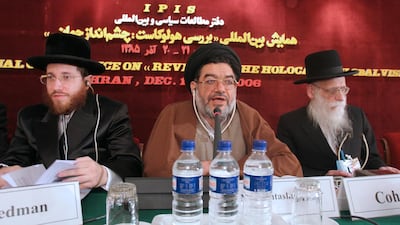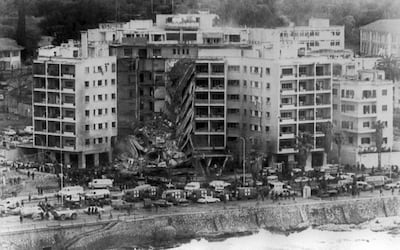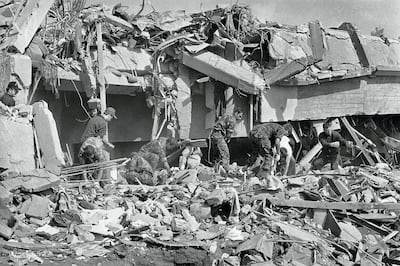Ali Akbar Mohtashamipour, a Shiite cleric who helped found the Lebanese militant group Hezbollah and lost his right hand to a book bombing reportedly carried out by Israel, died on Monday of Covid-19. He was 74.
A close ally of Iran's late supreme leader Ayatollah Ruhollah Khomeini, Mohtashamipour in the 1970s formed alliances with groups across the Middle East.
After the 1979 revolution, he helped found the Islamic Revolutionary Guard Corps (IRGC) in Iran and, as ambassador to Syria, took the force across the region to help form Hezbollah.
In his later years, he slowly joined the cause of reformists in Iran, hoping to change its theocracy from the inside.
He backed the opposition leaders Mir Hossein Mousavi and Mahdi Karroubi in Iran’s Green Movement protests that followed the disputed 2009 re-election of president Mahmoud Ahmadinejad.
"If the whole people become aware, avoid violent measures and continue their civil confrontation with that, they will win," Mohtashamipour said at the time, although Mr Ahmadinejad would remain in office.
“No power can stand up to people’s will.”
Mohtashamipour died at a hospital in northern Tehran after contracting the coronavirus, the state-run IRNA news agency reported.
The cleric, who wore a black turban that identified him in Shiite tradition as a direct descendant of the Prophet Mohammed, had been living in the Shiite holy city of Najaf, Iraq, over the last 10 years after the disputed election in Iran.
Hardline judiciary chief Ebrahim Raisi, now considered the leading candidate in Iran’s presidential election next week, offered condolences to Mohtashamipour’s family.
“The deceased was one of the holy warriors on the way to the liberation of Jerusalem and one of the pioneers in the fight against the usurping Zionist regime,” Mr Raisi said, according to IRNA.
Born in Tehran in 1947, Mohtashamipour met Khomeini as the cleric lived in exile in Najaf after being expelled from Iran by Shah Mohammad Reza Pahlavi.
In the 1970s, Mohtashamipour crossed the Middle East speaking to militants groups at the time, helping to form an alliance between what would become the Islamic republic and the Palestinian Liberation Organisation as it battled Israel.
Once arrested by Iraq, Mohtashamipour found his way to Khomeini's residence in exile outside of Paris. They returned triumphant to Iran in the 1979 revolution.
In 1982, Khomeini sent Mohtashamipour to Syria, then under the rule of dictator Hafez Assad.
While ostensibly a diplomat, Mohtashamipour oversaw the millions that poured in to fund the IRGC’s operations in the region.
Lebanon, then dominated by Syria, which sent tens of thousands of troops there, was invaded by Israel in 1982 as it pursued the PLO in Lebanon.
Iranian support flowed into the Shiite communities occupied by Israel. That helped create a militant group called Hezbollah, or “the Party of God”.
The US blames Hezbollah for the 1983 bombing of its embassy in Beirut, killing 63 people, as well as the bombing later that year of the US Marine barracks in the Lebanese capital that killed 241 US troops and another attack that killed 58 French paratroopers. Hezbollah and Iran denied being involved.
“The court finds that it is beyond question that Hezbollah and its agents received massive material and technical support from the Iranian government,” US District Judge Royce Lamberth wrote in 2003 after relatives of 241 US service personnel brought a case against Iran for the barracks bombing.
That opinion, quoting a US Navy intelligence official, directly named Mohtashamipour as being told by Tehran to reach out to the nascent Hezbollah to "instigate attacks against the multinational coalition in Lebanon, and 'to take a spectacular action against the United States Marines'".
An IRNA obituary of Mohtashamipour described him as “one of the founders of Hezbollah in Lebanon” and blamed Israel for the bombing that wounded him.
It did not discuss the US allegations about his involvement in the suicide bombings targeting Americans.
At the time of the assassination attempt on him, Israel's Mossad intelligence agency had received approval from prime minister Yitzhak Shamir to pursue Mohtashamipour, according to Rise and Kill First, a book on Israeli assassinations by journalist Ronen Bergman.
They chose to send a bomb hidden inside a book described as a “magnificent volume in English about Shiite holy places in Iran and Iraq” on Valentine’s Day in 1984, Bergman wrote.
The bomb exploded when Mohtashamipour opened the book, tearing away his right hand and two fingers on his left. But he survived, later becoming Iran’s interior minister and serving as a hardline lawmaker in parliament before joining reformists in 2009.



